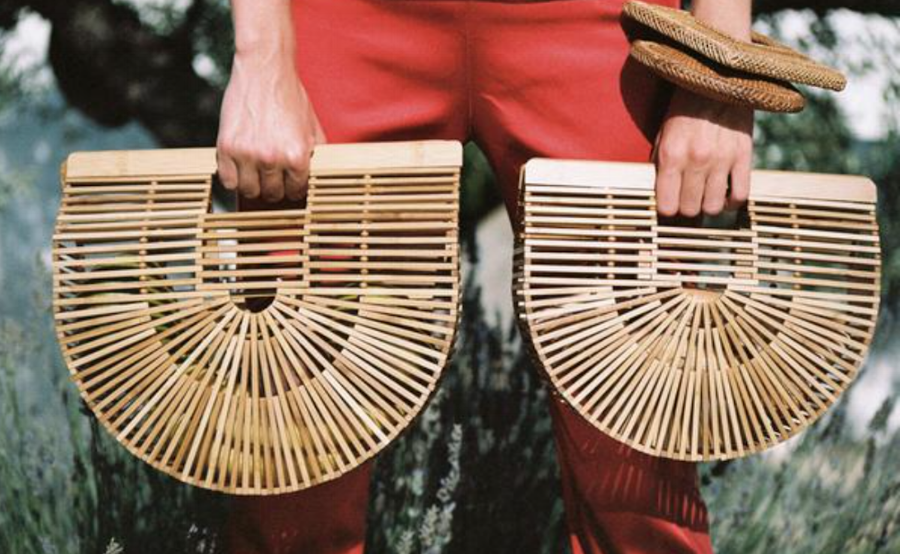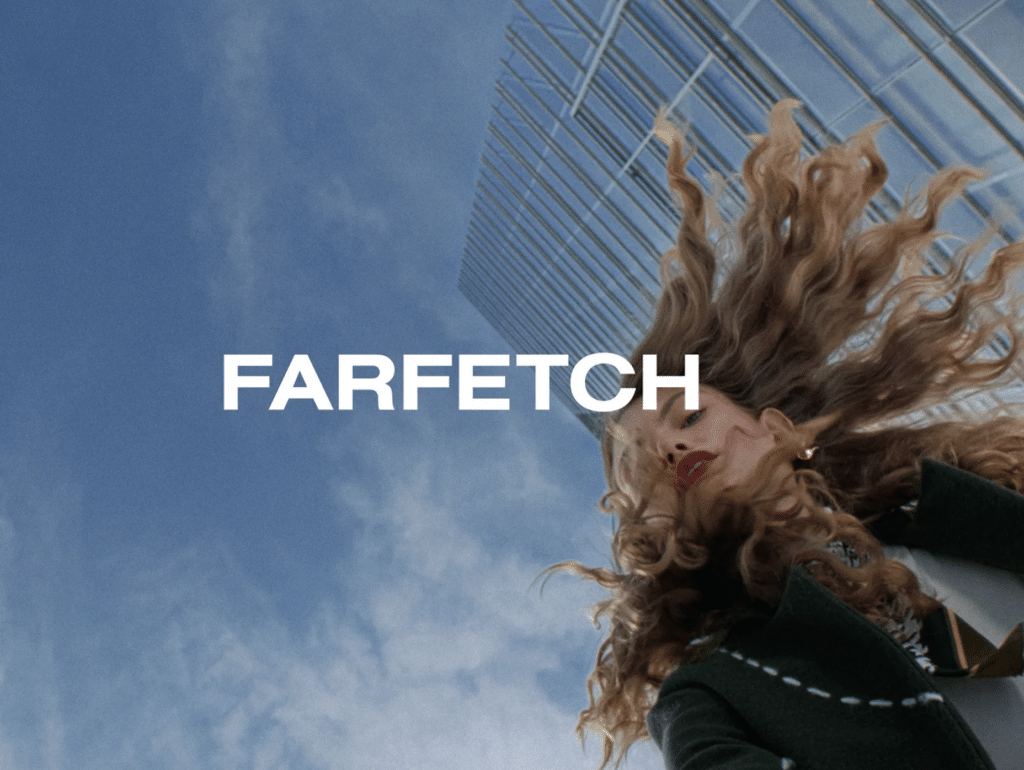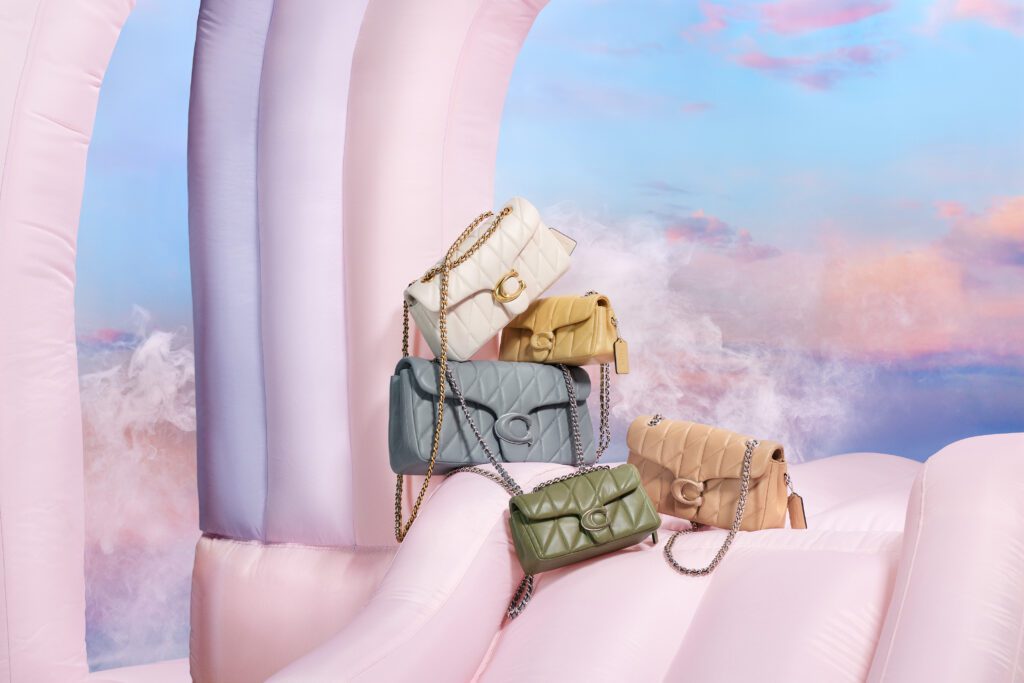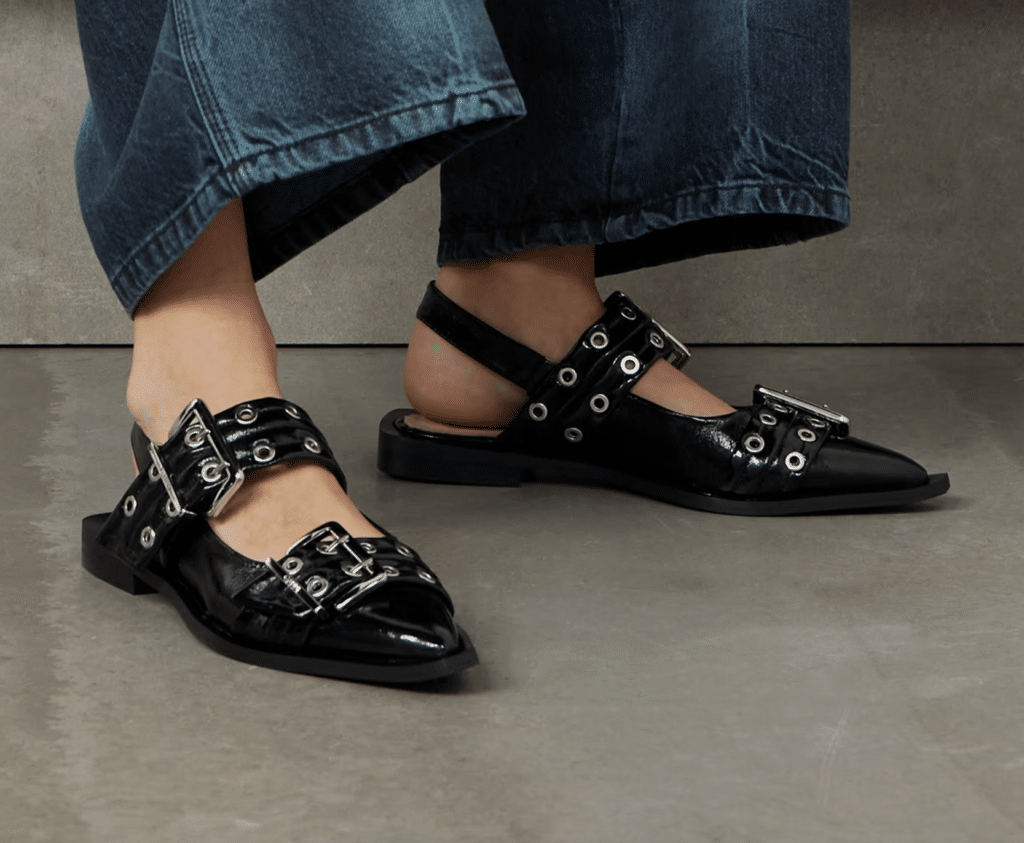In the balmy summer months of 2016, on the beaches of Malibu to the main streets of East Hampton, a new handbag was beginning to find favor amongst the well-established stable of designer “it” bags. With an intricate semi-circular shape, airy bamboo frame, and affordable price tag of $200 (that’s more than a $4,000 price difference compared to a summery salmon and magenta printed Chanel flap bag), the Ark bag was the newest contender for “must have” status.
The bag, itself, is the debut creation of a budding young brand called Cult Gaia. Jasmin Larian – the twenty-something spawn of billionaire toy tycoon Isaac Larian of Bratz franchise fame – had first conceived of the bag in 2013. From her brand’s headquarters in Los Angeles, she embarked on a mission to “quietly promote [the bag] by sending it to friends and family to wear,” and ideally, post on Instagram, Glamour’s Alexandra Ilyashov wrote this spring. Her strategy worked.
By the start of summer 2017, Cult Gaia’s bamboo Ark bag would stretch beyond the arms of in-the-know women populating domestic summer hotspots to those lazily posted up on the sunny beaches of the South of France or the ones club hopping into the wee hours of the morning in Mykonos. The eye-catching bag had saturated fashionable circles on Instagram and found its fair share of famous fans. Inevitably, the bag’s rise also birthed a whole slew of copycats from mass-market names, such as Steve Madden and ASOS, which set out to bank on the “new” style with cheaper alternatives.
Likely prompted by the smashing success of her first-ever bag and the growing number of lookalikes that were making their way onto the market, Larian turned her attention to legal protection. In July 2017, she filed an application for registration with the U.S. Patent and Trademark Office (“USPTO”) to protect the trade dress – i.e., the design and shape – of the bamboo Ark bag.
Almost from the outset, there was a problem. That problem, according to USPTO? Despite Larian’s claim that her brand, alone, should enjoy exclusive rights in the bamboo handbag design, she did not invent the Ark bag. In reality, the bag upon which she has built her brand is a dead ringer for one that had existed for roughly 80 years.
You see, long before Instagram influencers were pairing Cult Gaia’s Ark bag with zig-zag printed Missoni bikinis and gauzy, brightly-colored kaftans at Nikki Beach in St. Barth to Sunset Beach on Shelter Island, the bustling ports that dot the southern coast of Japan were where such a bag could be found.
Beginning in the late 1930’s, men coming and going from their shifts on Japanese fishing boats could be spotted carrying natural wooden bags. Constructed by local Japanese artisans from native bamboo stems, the bags – which would come to be known as “picnic bags,” since they were primarily used for carrying lunch – were particularly durable and simultaneously lightweight, making them a practical choice for many Japanese laborers.
It was these men that first popularized the bag design, but regardless of the genesis of the Cult Gaia bamboo bag design, Larian’s legal team filed an application for registration with the USPTO asserting legal ownership over the design.
Three months later, in October 2017, the USPTO made its thoughts on the matter known: it responded by preliminarily denying Larian’s application. The bag is not only functional in nature (“an absolute bar to registration” with the USPTO), it is directly derived from “a style of bag from the Japanese culture,” the trademark body’s examining attorney Bernice Middleton stated in a formal response to Larian’s counsel.
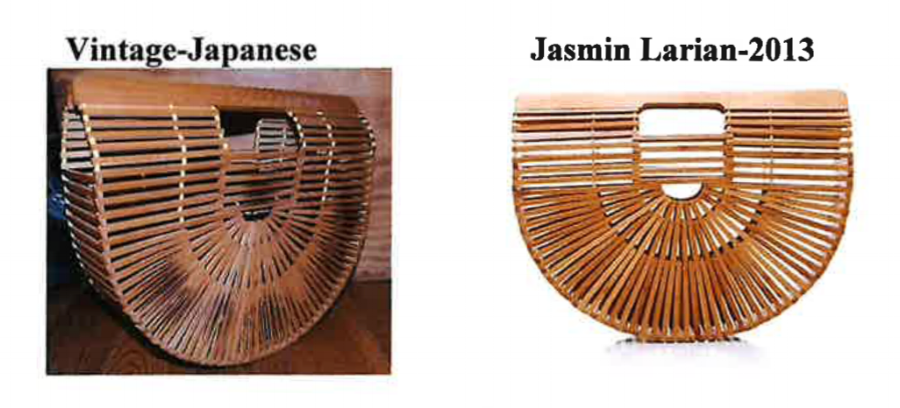 image via SDNY
image via SDNY
Cult Gaia may have “received recent notoriety” for its popularization of the half-moon shaped bamboo bag, and “while the style [of the bag] may have been promoted as the new ‘it’ style for a season with high sales,” the bag, itself, “is not new or distinct,” Middleton continued. Such a lack of originality is not necessarily a death knell, at least not from a trademark perspective. Unlike, say patent law, which provides protection only for novel inventions (or novel additions to existing inventions), trademark law places value more on actual and continued use of a mark or design than it does on originality.
However, even if trademark law does not outright oppose a lack of novelty, there would still be another roadblock in play for Larian, and it was not lost on Ms. Middleton.
Just as a brand’s logo or name must identify the source of the product upon which it appears – a swoosh logo on a sneaker, for instance, or the word “Chanel” inside of a handbag – to serve as a trademark, a product design must do the same thing in order to be protected by trade dress law. In other words, in order to be protectable, the appearance of the Ark bag needs to identify a single source in the mind of the average consumer.
The elements of the Ark bag do no such thing (and thus, the design of the Ark bag does not function as a trademark), according to Middleton, because the bag “is merely an iteration or appropriation” of an already-existing bag, one that many consumers are familiar with. In short: because of the widely recognized existence of the Japanese picnic bag, the average consumer would not be able to link Cult Gaia’s bamboo bag to one single source or brand, thereby, potentially taking trademark protection off of the table for Larian or anyone else for that matter.
Larian’s lawyer attempted to convince the USPTO’s examining attorney in a formal response that based on press mentions, sales figures, and attempts by others brands to copy the design (all of which are elements used to prove the secondary meaning required for trade dress protection), consumers have, in fact, come to associate the design of the Ark bag – namely, its “front and back panels made of thin, uniformly-sized strips of rigid material (such as bamboo),” “distinctive see-through sunburst design,” and “horizontal strips and a handle made of the same material with a curved, tapered cutaway – with a single source. And that source is the Cult Gaia brand.
As a result, the the brand’s lawyer argued, the bag design maintains trademark properties, and Cult Gaia is the rightful holder of those rights.
The USPTO was both unimpressed and unpersuaded by the evidence provided by the brand, including “social media articles and blog pieces about the bag.” To be exact, Middleton stated in a second refusal that “beyond a cursory look at pages from unseasoned fashion bloggers and ‘blogger babes of Instagram,’ true industry insiders, cultural institutions, critics and readers pushed back at any distinctiveness of the bag, in particular toting its cultural roots and past trends by higher and lower-end designers.”
Since “other designers and laymen have routinely utilized the style,” Middleton reiterated, it would be difficult – if not impossible – for the average consumer to associate the Ark bag design with a single source. “Merely reintroducing and training young Americans on how to stylishly wear a traditional piece via social media is not sufficient [to establish the design] as a source indicator for the goods,” she wrote, refusing to mince her words.
While Larian’s attempt to monopolize the design of the Ark bag is “not as blatant,” per Middleton, “as attempting to create a source indicator in bell-bottom pants, a fez, a kimono, a dashiki, moccasins and feather headdresses, tartans, Kente fabrics, saris, bento boxes, or Japanese wooden clog sandals, etc.,” it is still nothing more than “a distinct Japanese bag [style] well-known in the accessories industry.”
It would not be long before it became clear that Middleton is not the only one who has serious qualms with Larian’s attempt to register the bag design.
Less than a month after the USPTO examiner sent a second refusal to Larian, the Office of the Deputy Commissioner for Trademark Examination Policy accepted an unnamed third party’s letter protesting Larian’s application. The letter – which was formally submitted to the USPTO on July 26 for the purpose of aiding in the examination of the pending application – asserted that the Ark bag design “is functional” and consists of a “non-distinctive product design.” Attached to the letter were 200 pages of evidence – including images of lookalike bags that long pre-dated Larian’s Ark design, some from design texts – to bolster its points.
While Larian’s counsel is expected to file a response within 6 months of Middleton’s latest refusal (i.e., by February 5, 2019), no such filing has been made … yet. The latest development in the matter is something of a power move by Larian, nonetheless. The Cult Gaia owner has swapped in a new lawyer, trademark dynamo Andrea L. Calvaruso – the Kelley Drye attorney, who has represented Gucci, Salvatore Ferragamo, and Bottega Veneta, among others, in oft-difficult trademark fights – to help her secure a victory. It is now up to Calvaruso to show that not only is the bag not functional, but that the Cult Gaia design includes elements that have been “added to or differentiate from the original style [of bag] to create a source indicator for the goods.”
In the court of public opinion, Cult Gaia appears to be embroiled in a similarly tricky fight, finding no small number of opponents for what Barrett Block, writing for the Kentucky Law Journal this past fall, characterized as “capitalizing on the reproduction of the classic Japanese design.” In fact, it is not terribly easy to locate a discussion about the success of the Ark bag (and the Cult Gaia brand more generally) without at least a passing mention of the bag’s origin and its demonstration of fashion’s incessant penchant for taking inspiration in a manner that might be more appropriately labeled as appropriation.
“I love and admire your brand, but this is cultural appropriation,” wrote one Instagram user, referring to the Ark bag. “So, how isn’t Cult Gaia accused of cultural appropriation when it’s grabbing [a] traditional Japanese bag, calling it theirs and making a ton of money [by] fooling us all?,” asked another.
One of the most vocal nay-sayers of all is none other than Steve Madden. The New York-based mass market footwear and accessories giant, and serial copycat made an enemy out of Cult Gaia this spring on the heels of introducing its own version of the vintage Japanese picnic bag. After being slapped with a cease and desist letter from Larian’s lawyer, who threatened to file a trade dress infringement suit against Madden for copying Cult Gaia’s design, Madden beat Larian to it, and filed a lawsuit of its own in March 2018.
Steve Madden’s complaint seeks a declaration from the court that it has not run afoul of trademark law by “copying” Cult Gaia’s bag, and takes issue with Larian’s rights in the bamboo clutch. To be exact, Madden claims that Larian’s Ark bag “slavishly copies the traditional Japanese bamboo picnic bag design” and that the brand’s filing of a trade dress application is an “attempt to appropriate the traditional Japanese design for [herself].” That case is still underway in a New York federal court with no settlement in sight.
All the while, Cult Gaia has stood by its most popular design. Counsel for the brand, Aaron M. Wais of Mitchell Silberberg & Krupp LLP, told TFL shortly after Madden filed suit that “Cult Gaia is founded [on] the creativity and original designs of Jasmin Larian.”
As for the brand’s efforts to shut down those that copy the Ark bag design, one that Larian, herself, admitted in 2016 is “a reproduction of a Japanese bag that was popular in the ’40s” that she used “to collect,” Wais says, “We believe it is our duty to protect our hard-earned intellectual property assets on behalf of our retail partners – and customers who shop our website directly.”
Beyond the claims of appropriation being made here, there is an undeniable tinge of irony that comes with the attempt to monopolize a design and police others’ “unauthorized” uses of that design when it is taken almost exclusively from the public domain. Larian does not seem bothered by this technicality; she is busy building out her brand to include more than merely statement bags. For instance, Cult Gaia staged its first ready-to-wear runway show in Malibu last month and is expanding into menswear offerings, well.
Nary an article covering the brand’s first apparel outing failed to mention the Ark bag, which was, of course, in the hand of many a catwalker. Cult Gaia is, after all, synonymous with the bag. The brand was built upon the appeal of this bag. The only thing is: this does not necessarily go both ways. The same very well might not be true of the 80-year old traditional Japanese bag design’s relationship with the buzzy young fashion brand, no matter how many Instagram influencers say so.




